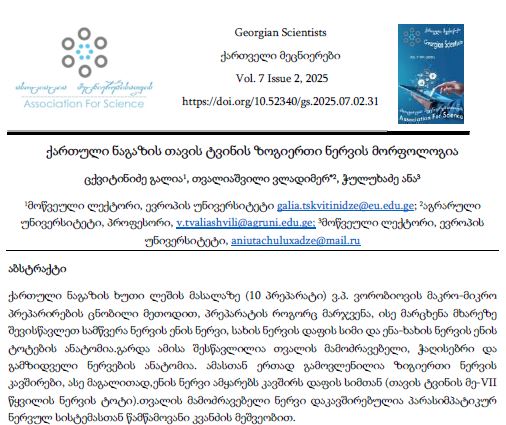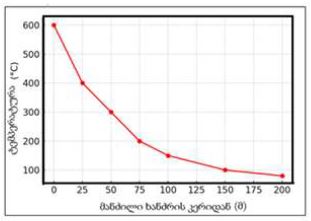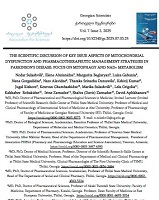The potential possibility of using food production waste to obtain products for medical and cosmetic use
Downloads
The article reviews some studies on the possibility of using production waste from the cobs of two types of corn (white and purple) to obtain a number of substances that are used, mainly in medicine and cosmetics. Data is provided on their chemical composition, the possibility of use in medicine, and on enzymatic production through a number of drugs, organic acids, enzyme preparations, alcohols and some others. The possibility of obtaining cosmetics is shown. In particular, powders of various types, creams, lotions. Many substances are obtained from corn cobs for further use in cosmetics and the food industry - powders, flour (for obtaining a special type of bread), oils, corn glycerides and unsaponifiable substances, germ extract and oil, gluten protein, hydrolyzed starch and a number of others. The cobs are used as sorbents and for the production of activated carbon. In conclusion, the economic feasibility of using cobs in a number of processes is pointed out. Today, in most cases, they are disposed of in ways that harm the environment.
Downloads
Hale Alan, Ali Rıza Köker. Analyzing and mapping agricultural waste recycling research: An integrative review for conceptual framework and future directions. Resources Policy, 2023, Volume 85, Part B, 103987.
Gandam, P.K.; Chinta, M.L.; Pabbathi, N.P.P.; Baadhe, R.R. and others . Second-generation bioethanol production from corncob–A comprehensive review on pretreatment and bioconversion strategies, including techno-economic and lifecycle perspective. Industrial Crops and Products. 2022, 186, 115245.
Yu Zou, Jun Fu, Zhi Chen, Luquan Ren. Field Decomposition of Corn Cob in Seasonally Frozen Soil and Its Intrinsic Influencing Factors: The Case of Northeast China. Agriculture 2021, 11(6), 556.
Jorge Pinto, Daniel Cruz, Anabela Paiva, Sandra Pereira. Characterization of corn cob as a possible raw building material. Construction and Building Materials. 2012, 34:28-33.
Polat, S. A Research on the Usage of Corn Cob in Producing Lightweight Concrete. Natural Resources. 2021, 10, Vol.12, 339-347.
Ahmed Ashour, Mohamed Amer, Amani Marzouk, Kuniyoshi Shimizu et al.. Corncobs as a Potential Source of Functional Chemicals. Molecules. 2013 Nov, 18(11): 13823–13830.
Vanessa Cunha Pimentel, Aleksandar Ašonja, Eleonora Desnica, Ljiljana Radovanovic. Energy efficiency analysis of corn cob used as a fuel. Energy sources. Part B Economics, planning and policy, 2017, 12(1):1-7.
Википедия https://ru.wikipedia.org ›
Википедия wiki5.ru https://wiki5.ru › wiki
Masatsugu Takada, Rui Niu, Eiji Minami, Shiro Saka. Characterization of three tissue fractions in corn (Zea mays) cob. Biomass and Bioenergy. 2018 August, Volume 115, Pages 130-135.
Nayda Karina Berber-Villamar, Alma Rosa Netzahuatl-Muñoz, Liliana Morales-Barrera, Griselda Ma. Chávez-Camarillo and others.Corncob as an effective, eco-friendly, and economic biosorbent for removing the azo dye Direct Yellow 27 from aqueous solutions. PLoS One. 2018, 13(4): e0196428.
Ahmed Ashour, Mohamed Amer, Amani Marzouk, Kuniyoshi Shimizu, Ryuichiro Kondo et al. Corncobs as a Potential Source of Functional Chemicals. Molecules.2013 Nov, 18(11): 13823–13830.
Fatah Sulaiman, Yati Adawiyah, Muhammad Iman Santoso, Meutia Maryani and others.Synthesis and Characterization of Silica Gel from Corn Cob Skin and Cob Waste. Proceedings of the 2nd International Conference for Smart Agriculture, Food, and Environment (ICSAFE 2021) Series: Advances in Biological Sciences Research.
Kaur, S.; Guleria, P.; Yadav, S.K. Evaluation of Fermentative Xylitol Production Potential of Adapted Strains of Meyerozyma caribbica and Candida tropicalis from Rice Straw Hemicellulosic Hydrolysate. Fermentation 2023, 9, 181.
Felipe A. F. Antunes, Jade B. F. Freitas, Carina A. Prado, Maria J. Castro-Alonso and others. "Valorization of Corn Cobs for Xylitol and Bioethanol Production through Column Reactor Process," Energies, 2023, MDPI, vol. 16(13), p. 1-15.
Efri Mardawati, R Andoyo, K A Syukra, MTAP Kresnowati, Y Bindar. Production of xylitol from corn cob hydrolysate through acid and enzymatic hydrolysis by yeast. IOP Conference Series: Earth and Environmental Science, 2nd International Conference on Biomass: Toward Sustainable Biomass Utilization for Industrial and Energy Applications 24–25 July 2017, Vol. 141, Bogor, Indonesia.
Francisco Riera, Ricardo Alvare, Jose Coca Prados. Production of furfural by acid hydrolysis of corncobs. April Journal of Chemical Technology & Biotechnology, 2007, 50(2):149 – 155.
Caio Cesar de Mello Capetti, Vanessa Oliveira Arnoldi Pellegrini, Melissa Cristina Espirito Santo, Anelyse Abreu Cortez and others. Enzymatic production of xylooligosaccharides from corn cobs: Assessment of two different pretreatment strategies. Carbohydrate Polymers, 2023 January, Volume 299, 1 120174.
Zhu, Junhua Di, Qing Li, Yu-Cai He , Cuiluan Ma .Enhanced conversion of corncob into furfurylamine via chemoenzymatic cascade catalysis in a toluene–water medium. Journal of Molecular Liquids . 2023, Volume 380, 121741.
Xiaoqing Wang, Davinia Salvachúa. Propionic acid production from corn stover hydrolysate by Propionibacterium acidipropionici. Biotechnology for Biofuels, 2017,10(1).
Joon-Pyo Lee, Jeongmi Lee, Kyoungseon Min. Development of bioprocess for corncob-derived levulinic acid production. Bioresource Technology, 2023, Volume 371,128628.
Alonso Malacara-Becerra,Elda M. Melchor-Martínez, L. María Riquelme-Jiménez, Seyed Soheil Mansouri et al. Bioconversion of Corn Crop Residues: Lactic Acid Production through Simultaneous Saccharification and Fermentation. Sustainability 2022, 14 (19), 11799.
Ting Lu, Yucui Hou, Weize Wu , Muge Niu and others. Formic acid and acetic acid production from corn cob by catalytic oxidation using O2. Fuel Processing Technology. 2018, March, Volume 171,Pages 133-139.
Yukai Suo, Zhengping Liao, Chunyun Qu, Hongxin Fu, Jufang Wang. Metabolic engineering of Clostridium tyrobutyricum for enhanced butyric acid production from undetoxified corncob acid hydrolysate. Bioresource Technology, 2019 January, Volume 271, Pages 266-273.
Thi Bich Huong Duong, Prattana Ketbot, Paripok Phitsuwan, Rattiya Waeonukul and others. Bioconversion of Untreated Corn Hull into L-Malic Acid by Trifunctional Xylanolytic Enzyme from Paenibacillus curdlanolyticus B-6 and Acetobacter tropicalis H-1. Microbiol Biotechnol. 2021 Sep 28, 31(9): 1262–1271.
U.G. Akpan, A.S. Kovo, M. Abdullahi. J. J. Ijah.TheProductionEthanol from Maize Cobs and Groundnut Shells. AU J.T. 2005, 9(2): 106-110.
Kumar Gandam, Madhavi Latha Chinta, Ninian Prem Prashanth Pabbathi, Rama Raju Baadhe. Second-generation bioethanol production from corncob – A comprehensive review on pretreatment and bioconversion strategies, including techno-economic and lifecycle perspective. Industrial Crops and Products . 2022 15 October, Volume 186, 115245.
Kedong Ma, Mingxiong He, Huiyan You, Liwei Pan and others. Improvement of (R,R)-2,3-butanediol production from corn stover hydrolysate by cell recycling continuous fermentation Chemical Engineering Journal. 2018, Volume 332, Pages 361-369.
Ravichandra Potumarthi , Rama Raju Baadhe, Annapurna Jetty.Mixing of acid and base pretreated corncobs for improved production of reducing sugars and reduction in water use during neutralization . Bioresource Technology, 2012 September, Volume 119, Pages 99-104.
Pradeep Kumar Gandam, Madhavi Latha Chinta, A. Priyadarshini Gandham, Ninian Prem Prashanth Pabbathiи and others. A New Insight into the Composition and Physical Characteristics of Corncob-Substantiating Its Potential for Tailored Biorefinery Objectives Fermentation 2022, 8(12), 704.
D.Araújo, M.Cidália, R. Castro, Aline Figueiredo, Maria Vilarinho , Ana Machado. .Green synthesis of cellulose acetate from corncob: Physicochemical properties and assessment of environmental impacts, Journal of Cleaner Production, 2020, Volume 260, 120865.
Xushuo Yuan, Jiaxin Zhao, Xiaoxiao Wu, Wentao Yao and others. Extraction of Corn Bract Cellulose by the Ammonia-Coordinated Bio-Enzymatic Method.Polymers (Basel). 2023 Jan, 15(1):Р. 206- 213.
Sri Winarsih, Devi Dwi Siskawardani . Hydrolysis of corncobs using a mixture of crude enzymes from Trichoderma reesei and Aspergillus niger for bioethanol production.7th International Conference on Energy and Environment Research, ICEER 2020, 14–18 September, ISEP, Porto, Portugal.
Jie Zhang, Mingyu Wang, Mintian Gao, Xu Fang and others. Efficient Acetone-Butanol-Ethanol Production from Corncob with a New Pretreatment Technology-Wet Disk Milling. Bio Energy Research 2012 March, 6 (1).
Amir IJAZ, Zahid ANWAR, Yusuf ZAFAR, Iqbal HUSSAIN and others. Optimization of cellulase enzyme production from corn cobs using. Alternaria alternata by solid state fermentation. Journal of Cell and Molecular Biology 2011, 9(2): 51-56.
S. Harini, R. Kumaresan. Production of cellulase from corn cobs by Aspergillus niger under submerged fermentation. International Journal of ChemTech Research. 2014,6(5):2900-2904.
Shaymaa A. Ismail, Shaimaa A. Nour, Amira A. Hassan. Valorization of corn cobs for xylanase production by Aspergillus flavus AW1 and its application in the production of antioxidant oligosaccharides and removal of food stain. Biocatalysis and Agricultural Biotechnology, 2022 May, Volume 41,102311.
Bindu Sunkar, Balakrishna Kannoju, and Bhima Bhukya. Optimized Production of Xylanase by Penicillium purpurogenum and Ultrasound Impact on Enzyme Kinetics for the Production of Monomeric Sugars From Pretreated Corn Cobs. Front Microbiol. 2020, 11: 772.
Andi Aliyah, Gandhi Alamsyah, Rizky Ramadhani, Heri Hermansyah. Production of α-Amylase and β-Glucosidase from Aspergillus niger by solid state fermentation method on biomass waste substrates from rice husk, bagasse and corn cob. Energy Procedia. 2017,136(4):418-423.
Josiani de Cassia Pereira , Rodrigo Simões Ribeiro Leite, Heloiza Ferreira Alves do Prado, Daniela Alonso Bocchini Martins, Eleni Gomes, Roberto da Silva. Production and characterization of β-glucosidase obtained by the solid-state cultivation of the thermophilic fungus Thermomucor indicae-seudaticae N31. Appl Biochem Biotechnol. 2015 Jan,175(2):723-32.
Xiaolong Han, Guodong Liu, Wenxia Song, Yinbo Qu. Production of sodium gluconate from delignified corn cob residue by on-site produced cellulase and co-immobilized glucose oxidase and catalase.Bioresource Technology 2018 January, Volume 248, Part A, P. 248-257.
Jeleke, S. B., Oyewole, O. A., Egwim, E. C., Dauda and others. CELLULASE AND PECTINASE PRODUCTION POTENTIALS OF ASPERGILLUS NIGER ISOLATED FROM CORN COB. Journal of Pure and Applied Sciences, 2012, 5(1): 78 – 83.
G. D. Ametefe, A. O. Lemo, F. A. Orji, A. K. Lawal and others. Pectinase Activities of Selected Fungi Grown on Agrowastes via Solid-state Fermentation. IOP Conference Series: Earth and Environmental Science, 3rd International Conference on Energy and Sustainable Environment 07/12/2021,Volume 1054.
Pablo D. Rocha, Leandro S. Oliveira, Adriana S. Franca .Sulfonated activated carbon from corn cobs as heterogeneous catalysts for biodiesel production using microwave-assisted transesterification. Renewable Energy. 2019, Volume 143, Pages 1710-1716.
AGA Siregar, R. Manurung , T. Taslim. Palm biodiesel production using by heterogeneous catalyst based corn cobs. IOP Conference Series: Materials Science and Engineering, Volume 505, 1st International Conference on Industrial and Manufacturing Engineering 2018 October 16, Medan City North Sumatera, Indonesia.
Fakhar Islam, Ali Imran, Muhammad Afzaal, Farhan Saeed and others. Nutritional, functional, and ethno-medical properties of sweet corn cob: a concurrent review. International Journal of Food Science & Technology, 2023, 8(28), р. 137-146.
MA. Yongqiang, ZHANG Kai, WANG Xin, LU Xuechun, LIN Congyu. Hypoglycemic Effect of Sweet Corn Cob Polysaccharide on Diabetic Rats. FOOD SCIENCE, 2020, Vol. 41 , Issue (13): 169-173.
Xiuhua Yu, Jianyuan Yin, Lin Li, Chang Luan, Jian Zhang (2015). Prebiotic potential of corncob-derived xylooligosaccharides and their in vitro antioxidant activity in combination with lactobacilli. Journal of Microbiology and Biotechnology, 2015, 25, 1084–1092.
Anti-inflammatory composition containing corn cob extract Патент Южной Кореи КР101895969B1В.
Wang, X., Wang, Z., Zhang, Q., Ma, Y. & Xu, W. Effect of sweet corn cob polysaccharide on pancreatic protein expression in type 2 diabetic rats. Journal of Functional Foods, 2022, 88, 104908.
Lau, T., Harborne, N. & Orunha-Concha, M. J. Enhancing the value of sweet corn (Zea mays) cobs by extracting valuable compounds. International Journal of Food Science and Technology, 2019, 54, 1240–1246.
Xiuhua Yu, Jianyuan Yin, Lin Li , Chang Luan and others. Prebiotic Potential of Xylooligosaccharides Derived from Corn Cobs and Their In Vitro Antioxidant Activity When Combined with Lactobacillus J Microbiol Biotechnol 2015 Jul, 25(7):1084-92.
Bushra Sultana, Farooq Anwar, Roman Przybylski .Antioxidant potential of corncob extracts for stabilization of corn oil subjected to microwave heating. Food Chemistry. 2007, Volume 104, Issue 3, Pages 997-1005.
Raniere Fagundes Melo-Silveira, Gabriel Pereira Fidelis, Mariana Santana Santos Pereira Costa, Cinthia Beatrice Silva Telles and others. In Vitro Antioxidant, Anticoagulant and Antimicrobial Activity and in Inhibition of Cancer Cell Proliferation by Xylan Extracted from Corn Cobs. Int J Mol Sci. 2012, 13 (1): 409–426.
J.A. Elegbede, V.A. Ajayi, A. Lateef. Microbial valorization of corncob: Novel route for biotechnological products for sustainable bioeconomy. Environmental Technology & Innovation. 2021 November, Volume 24, , 102073.
Zongyan Song, Xiong Xiong. Ultrasound-assisted extraction and characteristics of maize polysaccharides from different sites. Ultrasonics Sonochemistry. 2023 May, Volume 95, 106416.
Zhao Rui; Zhao Ou Lixia. The anticoagulant activity of polysaccharide and sulfate from corn-cob Published in: Proceedings 2011, International Conference on Human Health and Biomedical Engineering, 2011 19-22 August.
F Alan Andersen, Wilma F Bergfeld, Donald V Belsito, Curtis D Klaassen and others. Final report of the safety assessment of cosmetic ingredients derived from Zea mays (corn). Int J. Toxicol. 2011,30(3 Suppl):175-39S.
Production of facial powder using corncob. Modish Project. https://www.modishproject.com › ...
Euro Cobhttps://www.eurocob.com › ...
Hermann-Josef Stolz, Robert Bernicke. European Patent Office. Classification A61Q19/10 Publication EP1106173A3.06/01/2005.
Company advertising Caribbean Natural Products Inc. UL Prospector https://www.ulprospector.com › ...
Yetri Elisha, Harpolia Kartika .Composition of sunscreen based on corn cob extract (Zea maysM/em> L.) and robusta coffee bean extract (Coffea canephora Pierre ex A. Froehner) Asian Journal of Applied Sciences. 2020, 8 (6), 234-238.
Harpolia Cartika, Yetri Elisya, Fatwa Hasbi Hedonic. Test of Sunscreen Cream Combination of Corn Cob Extract (Zea mays L) and Robusta Coffee Bean Extract (Coffea Canephora Pierre Ex A. Froehner). Int J Sci Res Sci & Technol. 2023 November-December, 10 (6) : 353-359.
Asmienti, Jaliasreen Jalil and Tisna. Buditya Chandra Composition and Characteristics of Corn Cob (Zea mays L.) Extract Sunscreen Lotion. Universitas Muhammadiyah Purwokerto. 2019 https://digitallibrary.ump.ac.id › ...
Nattawadee Kanpipit , Natsajee Nualkaew , Suthasinee Thapphasaraphong .The Potential of Purple Waxy Corn Cob ( Zea mays L.) Extract Loaded-Sericin Hydrogel for Anti-Hyperpigmentation, UV Protection and Anti-Aging Properties as Topical Product Applications Pharmaceuticals (Basel). 2022 Dec 27,16(1):35- 40.
New Pig corn Cob Grain Absorbent for Cleaning Thick Spills https://www.newpig.com › ...
Bode Haryanto, IlhamTaufik Nasution, AflahFadliani Polem, Rondang Tambun, Vikram Alex and others. Natural adsorbent of corncob (Zea mays L.) powder capability in purification of used cooking oil with shaking operation based on turbidity. 2023 September, Volume 19, 101233.
Fatah Sulaiman, Yati Al Adawiyah, Muhammad Iman Santoso, Meutia Afifah, Yeyen Maryani. Synthesis and Characterization of Silica Gel from Corn Cob Skin and Cob Waste. Proceedings of the 2nd International Conference for Smart Agriculture, Food, and Environment (ICSAFE 2021).
Xiaoxue He,Xuexue Chen, Xinran Wang, Li Jiang. Optimization of activated carbon production from corn cob using response surface methodology Frontiers in Environmental Science, 2023, 11:1105408.
Gupta, GK; Ram, M.; Bala, R.; Kapoor, M.; Mondal, M.K. Pyrolysis of chemically treated corn cob for biochar production and its application for Cr(VI) removal. Environment. Prog. Support. Energy 2018, 37, 1606–1617.
Zhou, D.; Lee, D.; Lee, A.; Qi, M.; Cui, D.; Wang, H.; Wei, H. Activated carbon produced by reflux-microwave activation method with high methylene blue adsorption capacity. J. Environ. chem. English 2021, 9, 104671.
Wang, Y.; Hu, Y.; Qi, P.; Guo, L. A new approach to economical pretreatment of corn cobs. Adj. Sci. 2019, 9, 504.
Araujo, D.; Castro, M.C.R.; Figueiredo, A.; Vilarinho, M.; Machado, A. Green synthesis of cellulose acetate from corn cobs: physicochemical properties and environmental impact assessment. J. Clean. Cont. 2020, 260, 120865.
Vafakhah S, Bahrololoom ME, Bazarganlari R, Saeedikhani M. Removal of copper ions from electroplating effluent solutions with native corn cob and corn stalk and chemically modified corn stalk. J Environ Chem Eng. 2014, 2: 356–361.
Mured, F.; Nadeem, R.; Mehmood, A.; Siddique, M.; Bukhari, M. Biosorption of zinc by chemically modified corn cob (Zea mays L.) biomass. Middle East J. Sci. Res. 2012, 11, 1226–1231.
Ahmed, A. Y., Yasser, A. M. A., Norhan, S. S., & Farida, M. S. E. Removal of cadmium ions from wastewaters using corn cobs supporting nano-zero valent iron. Separation Science and Technology, 2019, 56(1), 1–13.
Arunkumar, C., Perumal, R., Lakshmi, N. S., & Arunkumar, J. Use of corn cob as low cost adsorbent for the removal of Nickel (II) from aqueous solution. International Journal of Advanced Biotechnology and Research (IJBR), 2014, 5(3), 325–330. http://www.bipublication.com.
Daliyanti A., Vidharyanti I.D., Curie K.A. Extraction and characterization of naturally occurring silica from corn waste. AIP conference minutes. 2019, 2085(1):020048.
Daliyanti A., Unitama D.A., Rofiko I.M. and others. FTIR silica xerogel from corn husks. Dataset.2021, 10.6084/m9.figshare.17073707.v1.
Daliyanti A., Unitama D.A., Rofiko I.M. and others. XRF data of silica xerogel synthesized from corn husks by the sol-gel method. Dataset.2021, 10.6084/m9.figshare.17073785.v1
Daliyanti A., Unitama D.A., Rofiko I.M. and others. Data from experiments on the adsorption of methylene blue on silica xerogel. Dataset.2021, 10.6084/m9.figshare.17074325.v1
Banerjee S, Chattopadhyaya MS. Adsorption characteristics for removal of toxic dye tartrazine from aqueous solutions using a low-cost agricultural by-product. Arab J. Chem. 2017, 10(6):S1629–S1638.
Naseem T., Baig M.M., Warsi M.F. and others. Mesoporous silica produced by green process: a comparative study on the removal of crystal violet from wastewater. Mater Res Express. 2020, 8 (1): 015005.
T. Lau, T. Clayton, N. Harbourne, J. Rodriguez-Garcia, M.J. Oruna-Concha. Sweet corn cob as a functional ingredient in bakery products. Food Chemistry X. 2022 March 30, Volume 13, 100180.
Yusnita Hamzah,Wong Fanglian. Asian Journal of Food and Agro-Industry. Physicochemical properties and acceptance of high fibre bread incorporated with corn cob flour .As. J. Food Ag-Ind. 2012, 5(06), 547-553.
Yang Z, Zhai W. Identification and antioxidant activity of anthocyanins extracted from the seed and cob of purple corn (Zea Mays L.). Innovative Food Science and Emerging Technologies. 2010,11(1):169-176.
Vayuphar B, Laksanalamai V. Antioxidant properties and color stability of anthocyanin purified extracts from Thai Waxy purple corn cob. Journal of Food and Nutrition Research. 2015, 3(10):629-636.
Salvador-Reyes R, Clerici MTPS. Peruvian Andean maize: General characteristics, nutritional properties, bioactive compounds and culinary uses. Food Research International. 2020, 130:108934.
Fernandez-Aulis F, Hernandez-vazguez L, Aguilar-osorio G, Arrieta-baez D, Navarro-Ocana A. Extraction and identification of anthocyanins in corn cob and corn husk from cacahuacintle maize. Journal of Food Science. 2019, 84(5):954-962.
Cevallos-Casals BA, Cisneros-Zevallos L. Stoichimetric and kinetic studies of phenolic antioxidants from Andean purple corn and red-fleshed sweetpotato. Journal of Agricultural and Food Chemistry. 2003, 51(11):3313-3319.
Salvador-Reyes R, Sampaio UM, de Menezes Alves Moro T, Brito ADC and others. Andean purple maize to produce extruded breakfast cereals: impact on techno-functional properties and sensory acceptance. Journal of the Science of Food and Agriculture, 2022, 103(2):548-559
Rebeca Salvador-Reyes, Ana Paula Rebellato, Juliana Azevedo Lima Pallone, Roseli Aparecida Ferrariи and others.Kernel characterization and starch morphology in five varieties of Peruvian Andean maize .Food Research International. Volume 140, February 2021, 110044.
Cevallos-Casals BA, Cisneros-Zevallos L. Stoichimetric and kinetic studies of phenolic antioxidants from Andean purple corn and red-fleshed sweetpotato. Journal of Agricultural and Food Chemistry. 2003, 51(11):3313-3319.
Ranilla L.G.; Rios-Gonzales B.A.; Ramirez-Pinto M.F.; Fuentealba C.; Pedreschi R.; Shetty K. Primary and Phenolic Metabolites Analyses, In Vitro Health-Relevant Bioactivity and Physical Characteristics of Purple Corn (Zea mays L.) Grown at Two Andean Geographical Locations. Metabolites. 2021, 11, 722-129.
Ranilla L.G.; Huaman-Alvino C.; Flores-Baez O.; Aquino-Mendez and others. Evaluation of phenolic antioxidant-linked in vitro bioactivity of Peruvian corn (Zea mays L.) diversity targeting for potential management of hyperglycemia and obesity. J. Food Sci. Technol. 2019, 56, 2909–2924.
Ramos-Escudero, Munoz A.M.; Alvarado-Ortız C.; Alvarado A. and others. Purple Corn (Zea mays L.) Phenolic Compounds Profile and Its Assessment as an Agent Against Oxidative Stress in Isolated Mouse Organs. J. Med. Food 2012, 15, 206–215.
Simla S.; Boontang S.; Harakotr B. Anthocyanin content, total phenolic content, and antiradical capacity in different ear components of purple waxy corn at two maturation stages. Aust. J. Crop Sci. 2016, 10, 675–682.
Kapcum C.; Uriyapongson J. Effects of storage conditions on phytochemical and stability of purple corn cob extract powder. Food Sci. Technol. 2018, 38, 301–305.
Pedreschi R.; Cisneros-Zevallos L. Antimutagenic and Antioxidant Properties of Phenolic Fractions from Andean Purple Corn (Zea mays L.). J. Agric. Food Chem. 2006, 54, 4557–4567.
Long N.; Suzuki S.; Sato S.; Ito A.N.; Sakatani K.; Shirai T.; Takahashi S. Purple corn color inhibition of prostate carcinogenesis by targeting cell growth pathways. Cancer Sci. 2013, 104, 298–303.
Mazewski C.; Liang K.; Mejia E.G.D. Inhibitory potential of anthocyanin-rich purple and red corn extracts on human colorectal cancer cell proliferation in vitro. J. Funct. Foods 2017, 34, 254–265.
Kang M.K.; Lim S.S.; Lee J.Y.; Yeo K.M.; Kang Y.H. Anthocyanin-Rich Purple Corn Extract Inhibit Diabetes-Associated Glomerular Angiogenesis. PLOS ONE. 2013, 8(11): e79823.
Joung H.; Kim C.H.; Lee Y.; Kim S.K.; Do M.S. Anti-diabetic and Anti-Inflammatory Effects of Purple Corn Extract in High-Fat Diet Induced Obesity Mice. Korean J. Food Nutr. 2017, 30, 696–702.
Ranilla L.G.; Rios-Gonzales B.A.; Ramirez-Pinto M.F.; Fuentealba, C. and others. Primary and Phenolic Metabolites Analyses, In Vitro Health-Relevant Bioactivity and Physical Characteristics of Purple Corn (Zea mays L.) Grown at Two Andean Geographical Locations. Metabolites 2021, 11, 722.
Ferron L.; Colombo R.; Mannucci B.; Papetti A. A New Italian Purple Corn Variety (Moradyn) Byproduct Extract: Antiglycative and Hypoglycemic In Vitro Activities and Preliminary Bioaccessibility Studies. Molecules 2020, 25, 1958-1966.
Luna-Vital D.A.; Mejia E.G.D. Anthocyanins from purple corn activate free fatty acid-receptor 1 and glucokinase enhancing in vitro insulin secretion and hepatic glucose uptake. PLoS ONE 2018; 13, e0200449.
Hong S.H.; Heo J.I.; Kim J.H.; Kwon S.O. and others. Anti-diabetic and Beta Cell-Protection Activities of Purple Corn Anthocyanins. Biomol. Ther. 2013, 21, 284–289.
Zhang Q.; Luna-Vital D.; Mejia E.G.D. Anthocyanins from colored maize ameliorated the inflammatory paracrine interplay between macrophages and adipocytes through regulation of NF-κB and JNK-dependent MAPK pathways. J. Funct. Foods 2019, 54, 175–186.
Chen C.; Somavat P.; Singh V.; Mejia E.G.D. Chemical characterization of proanthocyanidins in purple, blue, and red maize coproducts from different milling processes and their anti-inflammatory properties. Ind. Crops Prod. 2017, 109, 464–475.
Lee K.Y.; Hong S.Y.; Kim T.H.; Kim J.E. and others. Inhibition of pancreatic lipase activity and adipocyte differentiation in 3t3-l1 cells treated with purple corn husk and cob extracts. J. Food Hyg. Saf. 2018, 33, 131–139.
Ranilla L.G.; Christopher A.; Sarkar D.; Shetty K.; and others. Phenolic Composition and Evaluation of the Antimicrobial Activity of Free and Bound Phenolic Fractions from a Peruvian Purple Corn (Zea mays L.) Accession. J. Food Sci. 2017, 82, 2968–2976.
Zhao X.; Zhang C.; Guigas C.; Ma Y.; Corrales M.; Tauscher B.; Hu X. Composition, antimicrobial activity, and antiproliferative capacity of anthocyanin extracts of purple corn (Zea mays L.) from China. Eur. Food Res. Technol. 2009, 228(5): 759–765.
Poorahong W.; Innajak S.; Ungsurungsie M.; Watanapokasin R. Purple Corn Silk Extract Attenuates UVB-Induced Inflammation in Human Keratinocyte Cells. Sci. Pharm. 2022, 90(1), 18.
Кахетелидзе М.Б., Кикалишвили Б. Ю., Габелая М.А., Явич П.А., Мcхиладзе Л.В. Потенциальная возможность применения отходов пищевых производств для получения средств медицинского и косметического применения. Georgian Scientists. 2023,Vol.5, Issue 2,150-163.
Copyright (c) 2024 Georgian Scientists

This work is licensed under a Creative Commons Attribution-NonCommercial-NoDerivatives 4.0 International License.










































































































































































































